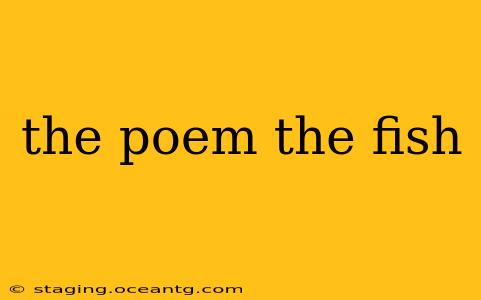Elizabeth Bishop's "The Fish" is more than just a descriptive poem; it's a meditation on life, death, and the interconnectedness of all things. Through vivid imagery and careful attention to detail, Bishop crafts a powerful and moving piece that continues to resonate with readers decades after its publication. This exploration delves into the poem's central themes, its masterful use of language, and the questions it raises about our relationship with the natural world.
What is the main idea of Elizabeth Bishop's poem "The Fish"?
The central theme of "The Fish" revolves around the speaker's encounter with an old, magnificent fish. It's not simply about the act of catching and releasing the fish, but rather a profound reflection on the creature's resilience, its beauty, and the inherent dignity of life. Bishop uses the fish as a symbol to explore broader themes of aging, survival, and the complex relationship between humans and nature. The poem ultimately celebrates the fish's life and encourages a deeper appreciation for the natural world. It moves beyond a simple narrative of fishing and becomes a philosophical contemplation.
What are the important symbols in Elizabeth Bishop's "The Fish"?
Several potent symbols contribute to the poem's richness and depth. The fish itself is the most obvious symbol, representing age, resilience, and the enduring power of life. Its scarred body and worn appearance symbolize the battles it has survived, highlighting its strength and tenacity. The five hooks embedded in its mouth symbolize the burdens and hardships endured throughout its life, both natural and human-inflicted. The "rainbow" colors of the fish's body symbolize the beauty and wonder of nature, which often goes unnoticed in our busy lives. Finally, the act of releasing the fish symbolizes compassion, respect, and a recognition of the interconnectedness of all living things.
What is the tone of Elizabeth Bishop's "The Fish"?
The poem's tone is remarkably multifaceted. It begins with a sense of excitement and triumph over catching the fish, quickly shifting to awe and admiration as the speaker observes the fish's remarkable characteristics. There's a palpable sense of respect evident in the speaker's decision to release the fish, tinged with a hint of melancholy for the creature's struggles and the inevitable cycle of life and death. The poem's concluding lines evoke a sense of peace and quiet contemplation, leaving the reader with a lingering feeling of wonder.
What is the significance of the poem's ending?
The ending is crucial to the poem's overall meaning. The speaker's decision to release the fish signifies a profound shift in perspective. Instead of viewing the fish as a prize to be kept or displayed, the speaker recognizes the fish's intrinsic value and the beauty of its life. The poem’s final lines, “I let the fish go,” are deceptively simple, yet they encapsulate a powerful message about compassion, respect, and the ethical responsibility we have towards the natural world. It’s a quiet, profound act of empathy that leaves a lasting impression.
What kind of poem is "The Fish"?
"The Fish" is primarily a narrative poem, detailing the speaker's encounter with a fish. However, it transcends a simple narrative, incorporating elements of descriptive poetry through the vivid imagery and detailed observations. Its exploration of deeper themes elevates it beyond a purely descriptive work, making it a richly layered and philosophical poem.
What does the title "The Fish" signify?
The title itself, "The Fish," is deceptively simple yet highly effective. Its straightforwardness underscores the poem's focus on a singular creature, yet it also hints at the broader implications and deeper meanings that the poem explores. The singular nature of the title draws attention to the unique individuality and dignity of the fish.
Through careful observation and poetic skill, Bishop crafts a poem that is both beautifully descriptive and profoundly evocative. "The Fish" remains a powerful testament to the enduring power of nature and our responsibility to appreciate and respect the living world around us. It’s a work that rewards repeated readings, offering new layers of meaning and understanding with each encounter.
